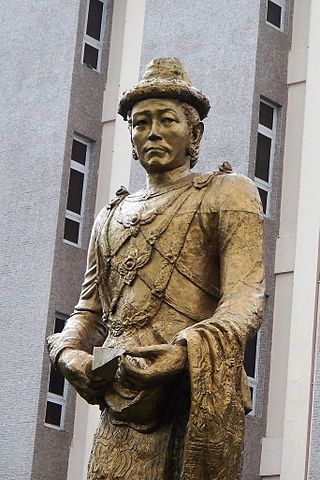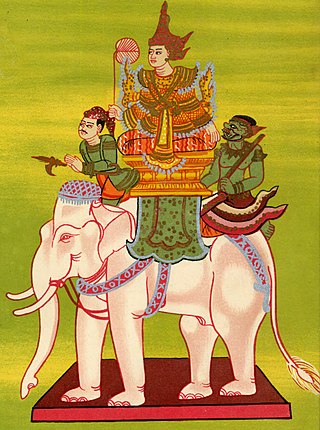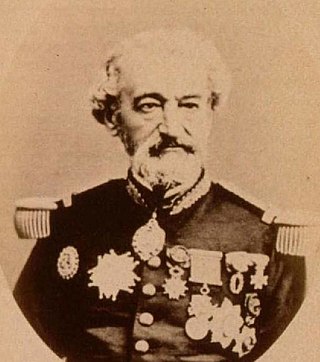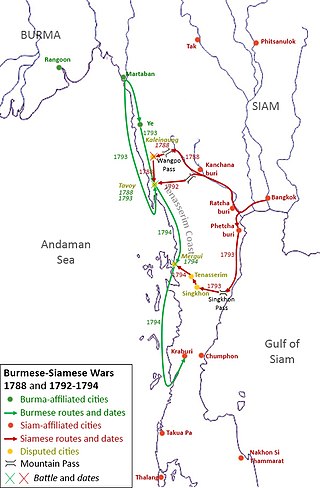Related Research Articles

Mindon Min, born Maung Lwin, was the penultimate king of Burma (Myanmar) from 1853 to 1878. He was one of the most popular and revered kings of Burma. Under his half brother King Pagan, the Second Anglo-Burmese War in 1852 ended with the annexation of Lower Burma by the British Empire. Mindon and his younger brother Kanaung overthrew their half brother King Pagan. He spent most of his reign trying to defend the upper part of his country from British encroachments, and to modernize his kingdom.

Alaungpaya was the founder of the Konbaung Dynasty of Burma (Myanmar). By the time of his death from illness during his campaign in Siam, this former chief of a small village in Upper Burma had unified Burma, subdued Manipur, conquered Lan Na and defeated the French and the British who had given help to the Restored Hanthawaddy Kingdom. He added settlements around Dagon, and called the enlarged town Yangon.

Hsinbyushin was king of the Konbaung dynasty of Burma (Myanmar) from 1763 to 1776. The second son of the dynasty founder Alaungpaya is best known for his wars with Qing China and Siam, and is considered the most militaristic king of the dynasty. His successful defense against four Qing invasions preserved Burmese independence. His 1765 invasion of Ayutthaya brought an end to the Ayutthaya Kingdom. The near simultaneous victories over Qing and Siam has been referred to as testimony "to a truly astonishing elan unmatched since Bayinnaung." He also raised the Shwedagon Pagoda to its current height in April 1775.
Dabayin Min, commonly known as Naungdawgyi was the second king of Konbaung Dynasty of Burma (Myanmar), from 1760 to 1763. He was a top military commander in his father Alaungpaya's reunification campaigns of the country. As king, he spent much of his short reign suppressing multiple rebellions across the newly founded kingdom from Ava (Inwa) and Toungoo (Taungoo) to Martaban (Mottama) and Chiang Mai. The king suddenly died less than a year after he had successfully suppressed the rebellions. He was succeeded by his younger brother Hsinbyushin.
Binnya Dala was the last king of Restored Kingdom of Hanthawaddy, who reigned from 1747 to 1757. He was a key leader in the revival of the Mon-speaking kingdom in 1740, which successfully revolted against the rule of Toungoo dynasty. Though Smim Htaw Buddhaketi was the king, it was Binnya Dala who was the prime minister that wielded power. After the nominal king abdicated in 1747, Binnya Dala, a local Mon nobleman with a Burman given name of Aung Hla, was elected king of the Mon-speaking kingdom.

Tanintharyi Region is an administrative region of Myanmar, covering the long narrow southern part of the country on the upper Malay peninsula, reaching to the Kra Isthmus. It borders the Andaman Sea to the west and the Tenasserim Hills, beyond which lie Thailand, to the east. To the north is the Mon State. There are many islands off the coast, the large Mergui Archipelago in the southern and central coastal areas and the smaller Moscos Islands off the northern shores. The capital of the division is Dawei (Tavoy). Other important cities include Myeik (Mergui) and Kawthaung. The division covers an area of 43,344.9 square kilometres (16,735.6 sq mi), and had a population of 1,406,434 at the 2014 Census.
Pierre de Milard was a French Navy officer, who became a senior officer and noble in the Royal Burmese Armed Forces. He had a key role in supporting the Burmese military efforts against Siam and Qing China. He was lavishly rewarded for his efforts, and made the governor of Tabe. De Milard was very close to King Hsinbyushin. Suffering from a long illness in his last years, the Burmese king asked de Milard on a few occasions to sleep in the same room in order to guard against possible attempts on his life.

France-Myanmar relations are the bilateral relations between Myanmar and France. Relations began in the early 18th century, as the French East India Company was attempting to extend its influence into Southeast Asia. France has an embassy in Yangon and Myanmar has an embassy in Paris.

The Second Anglo-Burmese War or the Second Burma War was the second of the three wars fought between the Burmese Empire and British Empire during the 19th century. The war resulted in a British victory with more Burmese territory being annexed to the Company Raj.
Admiral Sir George Robert Lambert was a Royal Navy officer who went on to be Commander-in-Chief, The Nore.

Hikayat Abdullah is a major literary work by Abdullah bin Abdul Kadir, a Malacca-born Munshi of Singapore. It was completed in 1845 and first published in 1849, making it one of the first Malay literary texts to be published commercially. Abdullah's authorship was prominently displayed in this text and the contents were conveyed in simple, contemporary Malay. Unlike typical classical Malay literary works that contain mythical and legendary stories, Abdullah's work dealt with social realism.
Minkhaung Nawrahta was a general of the Royal Burmese Army of the Konbaung Dynasty during the reign of King Alaungpaya. He is best known for his rearguard defense in the Burmese-Siamese War (1759–1760) in Siam as the Burmese forces rushed back a dying Alaungpaya back home. The general, who was well respected by the troops, then rebelled against Alaungpaya's successor Naungdawgyi. He believed he would be executed by the new king with whom he had a long history of enmity. The rebel general seized Ava in June 1760, and withstood the siege for over five months. He was killed by a musket shot as he fled the city in December. A remorseful Naungdawgyi was said to have mourned at the news of the death of his adversary and his father's brother in arms.
The Burmese–Siamese wars also known as the Yodian wars, were a series of wars fought between Burma and Siam from the 16th to 19th centuries.
Sri Maharaja Sang Sapurba Paduka Sri Trimurti Tri Buana, (1245–1316) also known as Sri Nila Pahlawan, is a figure in the Malay Annals, highly revered as the legendary great ancestor of some of the major dynasties of the Malay world: Singapura, Malacca, Pahang, Johor, Perak, Kelantan, Terengganu and Siak Sri Indrapura. Legend has it that after his accession to Seguntang Hill with his two younger brothers, Sang Sapurba enters into a sacred covenant with Demang Lebar Daun the native ruler of Palembang, which laid the basis of the proper relationship between the Malay rulers and the subjects. The legendary sword believed to be carried by the king, the Cura Si Manjakini, is now formed part of the regalia of Perak Sultanate, whose rulers are said directly descended from the king. The details of Sang Sapurba stories are mainly composed of folklore and legends, and thus his historical existence is debated and disputed by modern historians. Even so, as De Jong argued in her article The Character of Malay Annals, the stories of the Malay Annals could have been realistically mixed with the historical figures and events.
The following is a timeline of the history of the city of Yangon, Myanmar.
Gabriel Towerson, was a captain and agent for the East India Company.
Anti-Thai sentiment involves hostility or hatred that is directed towards people in Thailand, or the state of Thailand.

Marie-Jules Dupré was a French admiral. He was governor of Réunion from 1865 to 1869 under the Second French Empire, and governor of Cochinchina from 1871 to 1874 under the French Third Republic. He negotiated a treaty with the Emperor of Vietnam that opened up the country to French commerce and ceded territory in the south to France.
Kosa Lek was a Siamese trader, field general and minister. He was the older brother of Kosa Pan and Thao Sri Chulalak, the concubine of King Narai.

The Tavoy campaign of 1788 was a conflict between the Kingdom of Burma under Konbaung dynasty and the Kingdom of Siam under the Chakri dynasty over the town of Tavoy and the Tenasserim Coast.
References
- SOAS Bulletin of Burma Research, Vol. 2, No. 2, Autumn 2004, ISSN 1479-8484 ("A voyage to Pegu", translation of A Voyage to the East-Indies and China; Performed by Order of Lewis XV. Between the Years 1774 and 1781. Containing A Description of the Manners, Religion, Arts, and Sciences, of the Indians, Chinese, Pegouins, and of the Islanders of Madagascar; Also Observations on the Cape of Good Hope, the Isles of Ceylon, Malacca, the Philippines, and Moluccas. by Monsieur Sonnerat, Commissary of the Marine, (Vol. III, book 4, chapter 2).
- Keat Gin Ooi, Southeast Asia: A Historical Encyclopedia, from Angkor Wat to East Timor ABC-CLIO, 2004 ISBN 1-57607-770-5, ISBN 978-1-57607-770-2